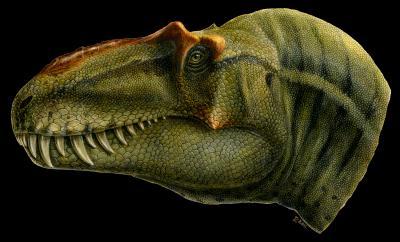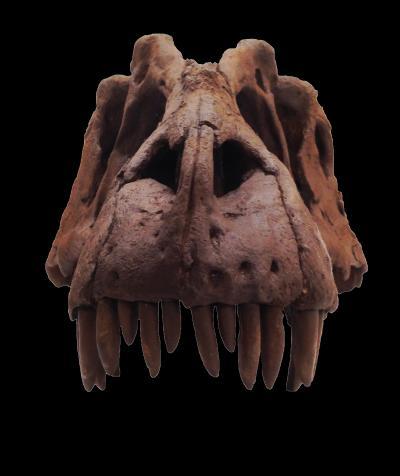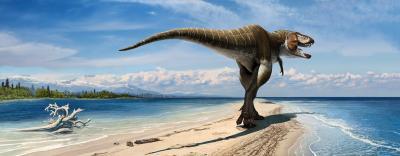A new species of tyrannosaur, Lythronax Argestes, has been unearthed in Grand Staircase-Escalante National Monument in southern Utah. Lythronax translates as "king of gore," and the second part of the name, argestes, refers to its geographic location in the American Southwest.
The huge carnivore inhabited Laramidia, a landmass formed on the western coast of a shallow sea that flooded the central region of North America, isolating western and eastern portions of the continent for millions of years during the Late Cretaceous Period, between 95-70 million years ago.
The newly discovered dinosaur, belonging to the same evolutionary branch as the famous Tyrannosaurus rex has been unveiled on exhibit in the Past Worlds Gallery at the Natural History Museum of Utah at the Rio Tinto Center in Salt Lake City, Utah.

Artistic rendition of the new tyrannosaur Lythronax. Credit: Lukas Panzarin
Among tyrannosaurs, a group of small to large-bodied, bipedal carnivorous dinosaurs including T. rex that lived during the Jurassic and Cretaceous periods, Lythronax argestes possesses several unique features; a short narrow snout with a wide back of the skull with forward-oriented eyes.
Previously, paleontologists thought this type of wide-skulled tyrannosaurid only appeared 70 million years ago, whereas Lythronax shows it had evolved at least 10 million years earlier. The skeleton was found by a US Bureau of Land Management employee and then the researchers came in to excavate.
Lythronax lived on Laramidia, along the western shores of the great seaway that separated North America; this landmass hosted a vast array of unique dinosaur species and served as the crucible of evolution for iconic dinosaur groups such as the horned and duck billed dinosaurs. This study also indicates that tyrannosaurid dinosaurs (the group of tyrannosaurs that includes T. rex) likely evolved in isolation on this island continent. Lythronax stands out from its contemporaries in having a much wider skull at the eyes and a narrow short snout, similar to its relative T. rex, which lived 10-12 million years later.
Dr. Mark Loewen, the study's lead author, noted, "The width of the back of the skull of Lythronax allowed it to see with an overlapping field of view—giving it the binocular vision— very useful for a predator and a condition we associate with T. rex." Previously, paleontologists thought this type of wide-skulled tyrannosaurid only appeared ~70 million years ago, whereas Lythronax shows it had evolved at least 10 million years earlier.

This skull, which includes pieces of real fossil, shows the unique features of this new tyrannosaur. Credit: Mark Loewen, NHMU
Paleontologists have recently determined that the dinosaurs of southern Laramidia (Utah, New Mexico, Texas, and Mexico), although belonging to the same major groups, differ at the species level from those on northern Laramidia (Montana, Wyoming, the Dakotas, and Canada). Lythronax and its tyrannosaurid relatives on southern Laramidia are more closely related to each other than the long snouted forms from northern Laramidia.
Dr. Joseph Sertich, a co-author of the study, stated that, "Lythronax may demonstrate that tyrannosaurs followed a pattern similar to what we see in other dinosaurs from this age, with different species living in the north and south at the same time."
These patterns of dinosaur distribution across Laramidia lead the researchers to ask what might have caused the divisions between the north and south, given that an enterprising dinosaur could have walked from Alaska to Mexico if given enough time. Dr. Randall Irmis, a study co-author, explained that by analyzing the evolutionary relationships, geologic age, and geographic distribution of tyrannosaurid dinosaurs, the team determined that "Lythronax and other tyrannosaurids diversified between 95-80 million years ago, during a time when North America's interior sea was at its widest extent.

A landscape view of Lythronax. Credit: Andrey Atuchin
The incursion of the seaway onto large parts of low-lying Laramidia would have separated small areas of land from each other, allowing different species of dinosaurs to evolve in isolation on different parts of the landmass." As the seaway gradually retreated after 80 million years ago, these differences in dinosaur species may have been reinforced by climate variations, differences in food sources (different prey and plants), and other factors. This hypothesis explains why the iconic Late Cretaceous dinosaurs of western North America are so different from those of the same age on other continents.
A Treasure Trove of Dinosaurs on the Lost Continent of Laramidia
Lythronax was discovered in Grand Staircase-Escalante National Monument (GSENM), which encompasses 1.9 million acres of high desert terrain in south-central Utah. This vast and rugged region, part of the National Landscape Conservation System administered by the Bureau of Land Management (BLM), was the last major area in the lower 48 states to be formally mapped by cartographers. Today GSENM is the largest national monument in the United States. Co-author Dr. Scott Sampson proclaimed that, "Grand Staircase-Escalante National Monument is the last great, largely unexplored dinosaur boneyard in the lower 48 states."
Dr. Philip Currie, another co-author, stated that,"Lythronax is a wonderful example of just how much more we have to learn about with world of dinosaurs. Many more exciting fossils await discovery in Grand Staircase-Escalante National Monument."
Citation: Loewen MA, Irmis RB, Sertich JJW, Currie PJ, Sampson SD (2013) Tyrant Dinosaur Evolution Tracks the Rise and Fall of Late Cretaceous Oceans. PLoS ONE 8(11): e79420. doi:10.1371/journal.pone.0079420




Comments